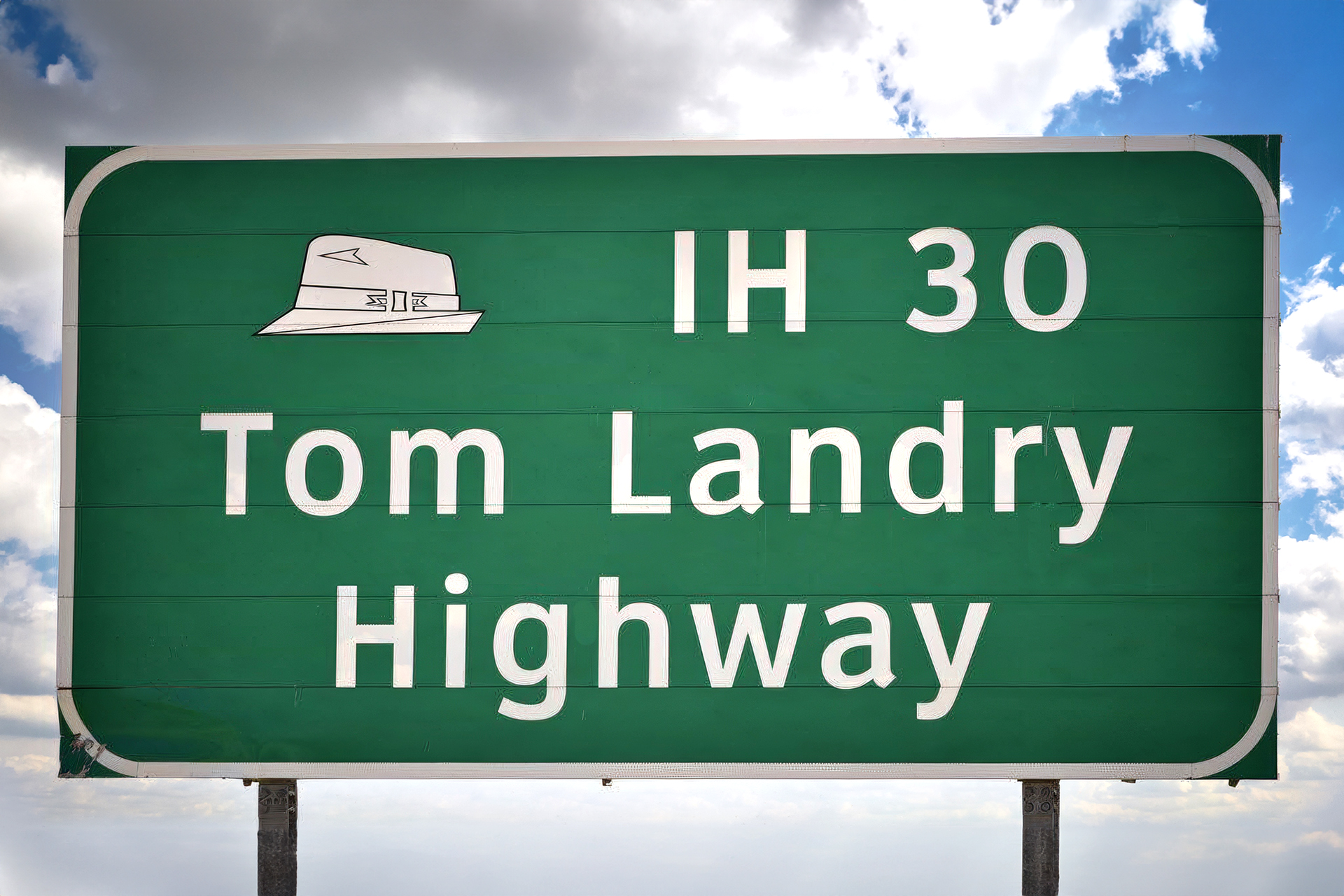
The Highways that Helped Make Arlington America's Mid-City, Part 1 of 3: IH-30 (Tom Landry Highway)
The following is an excerpt from Oscar Slotboom's meticulously researched and excellent book (and website) Dallas-Fort Worth Freeways, reprinted here with kind permission from the author. The editor has provided supplemental material to bring the article up-to-date on Arlington's stadiums and amusement facilities.
When it first opened as the Dallas-Fort Worth Turnpike in 1957, it brought hopes of bringing cooperation between Dallas and Fort Worth, cities which had historically been rivals and oftentimes enemies. While Dallas and Fort Worth still maintained some rivalry in 2001, there was one thing everyone agreed on: the freeway connecting the two cities should be named for legendary Cowboys coach Tom Landry. The formal designation took place on October 30, 2001, in a ceremony at Reunion Arena in Dallas which featured the unveiling of the official Tom Landry Highway sign. Landry’s trademark fedora hat adorns the highway sign and is featured in architectural enhancements on the freeway structures in Dallas.
Tom Landry, 1924-2000
Tom Landry is among the most successful head coaches in the history of the NFL and is also among its most distinctive with his sideline demeanor, well-dressed appearance and trademark fedora hat.
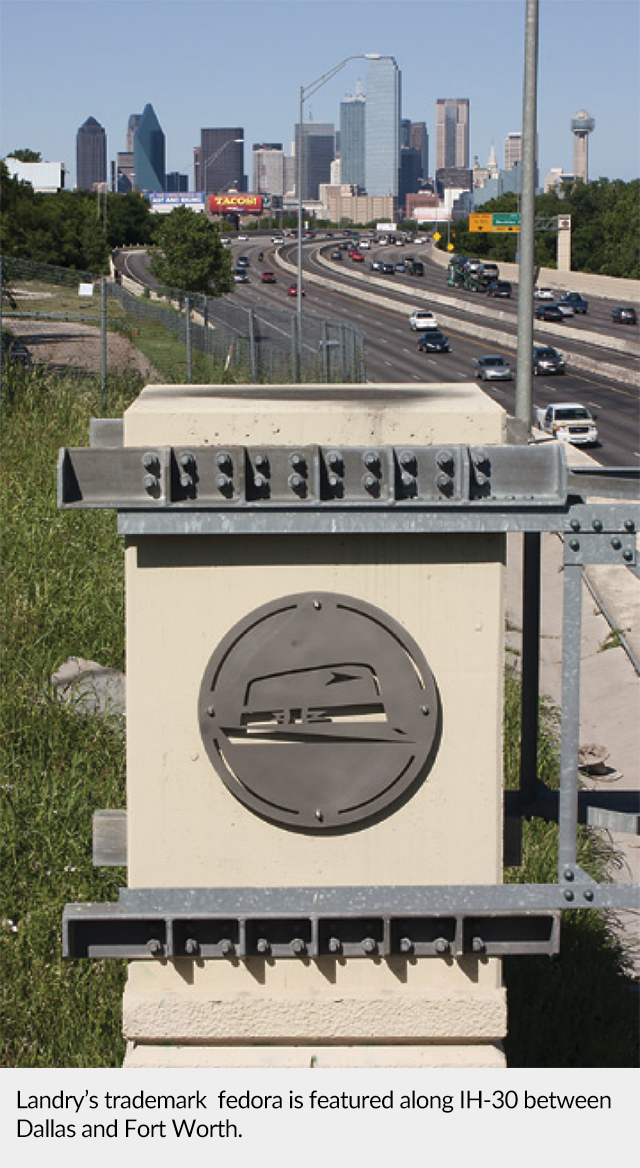
Born in Mission, Texas, on September 11, 1924, Landry first showed his outstanding athletic skills at Mission High School. After starting studies at the University of Texas at Austin, Landry was called into World War II service in February 1943. Landry became a B-17 pilot and flew 30 missions over northern Europe including a crash landing in France where the crew escaped uninjured. Landry returned to Austin where he met his wife Alicia, captained the Longhorns to victory in the 1949 Orange Bowl and graduated with a business degree in 1949.
Landry had a successful NFL playing career as a defensive back with the New York Giants from 1950 to 1955, serving as a player-coach in 1954 and 1955. Landry became a full-time defensive assistant coach for the Giants from 1956 to 1959. The Cowboys were a new expansion franchise for 1960 and Landry was hired as head coach at the age of 35. Landry would serve as head coach for the next 29 seasons. After some difficult losing seasons in the early 1960s, the Cowboys went 7-7 in 1965 and then 10-3-1 in 1966. It was the start of a twenty-year streak of winning seasons under Landry, an NFL record. The Cowboys were a dominating presence in the NFL in the 1970s, appearing in five Superbowls and winning twice in 1972 and 1978. Landry’s coaching career ended on February 25, 1989, the day the Cowboys were purchased by Jerry Jones who replaced Landry with Jimmy Johnson. Landry died February 12, 2000, of leukemia at age 75.
In addition to the most consecutive winning seasons (20), Landry holds the record for the most playoff victories (20). Landry’s 250 career wins is third on the all-time list, and he was inducted into the Pro Football Hall of Fame in 1990.
Landry was inducted into the exclusive Cowboys Ring of Honor at a Texas Stadium ceremony on November 7, 1993.
In commemoration of the Cowboys’ 50th season in 2009, the Dallas Morning News published a list of the top 50 Cowboys. At the top of the list: legendary head coach Tom Landry, who led the team from 1960 to 1989.
The top ten Cowboys as ranked by the Dallas Morning News, November 29, 2009, with active seasons (not necessarily corresponding to arrival and departure years):
1. Tom Landry (1960-1988)
2. Roger Staubach (1969-1979)
3. Emmitt Smith (1990-2002)
4. Bob Lilly (1961-1974)
5. Troy Aikman (1989-2000)
6. Tony Dorsett (1977-1987)
7. Randy White (1975-1988)
8. Michael Irvin (1988-1999)
9. Mel Renfro (1964-1977)
10. Tex Schramm (1959-1989)
The Dallas-Fort Worth Turnpike, August 27, 1957 - December 31, 1977
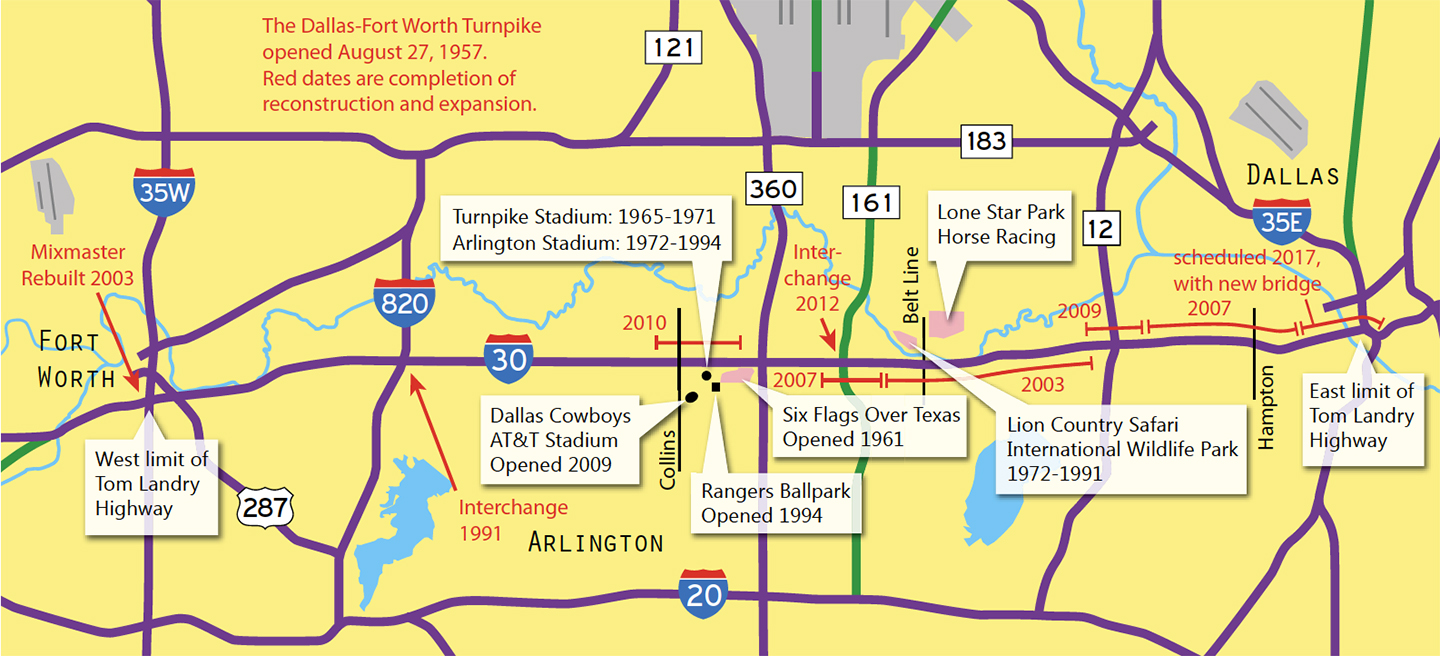
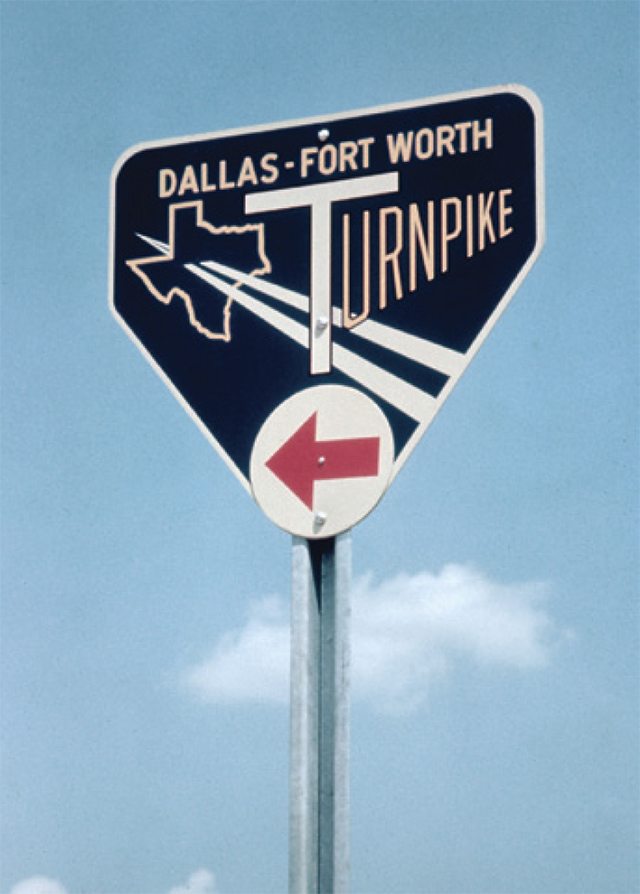
Amid the network of new freeways that was built during the 1960s freeway construction boom, there was one oddity—the freeway you had to pay to use, the Dallas-Fort Worth Turnpike. Opened in 1957, it was built unbelievably quickly by modern standards and was the first limited-access highway in North Texas to be built to modern design standards. While toll-paying motorists on the turnpike thought they were seeing a vision of the past, they were really seeing a vision of the future—a future that would start to take shape forty years later when virtually every new limited-access highway in North Texas would become a tollway. But before the toll juggernaut would seize control of North Texas, the Dallas-Fort Worth Turnpike distinguished itself as the only tolled facility to become free in the history of Texas.
Origins
The first comprehensive study for an east-west superhighway between Dallas and Fort Worth was prepared by Parsons Brinkerhoff engineers in 1944. The proposal for the 42.7-mile expressway started east of Dallas, continued to west of Fort Worth and carried a then eye-popping $61 million price tag ($807 million in 2013 dollars). In Dallas, however, the proposed alignment was deemed unsuitable and the Parsons Brinkerhoff plan did not serve as a basis for future highway construction. Dallas officials designated the section from downtown eastward as a separate, high-priority project and the section west of downtown received less attention for the moment.
The Dallas and Fort Worth chambers of commerce continued to promote an expressway between Dallas and Fort Worth, and in 1952 Fort Worth was promoting a plan to connect the cities as quickly as possible with a $31 million freeway even if it meant toll financing. By the end of 1952 both chambers of commerce decided to pursue toll financing if conventional financing was not available within five years. With the huge backlog of highway projects competing for limited funding and both Dallas and Fort Worth focusing on other freeways in their cities, toll financing appeared to be the only way to build the full length of the expressway quickly.
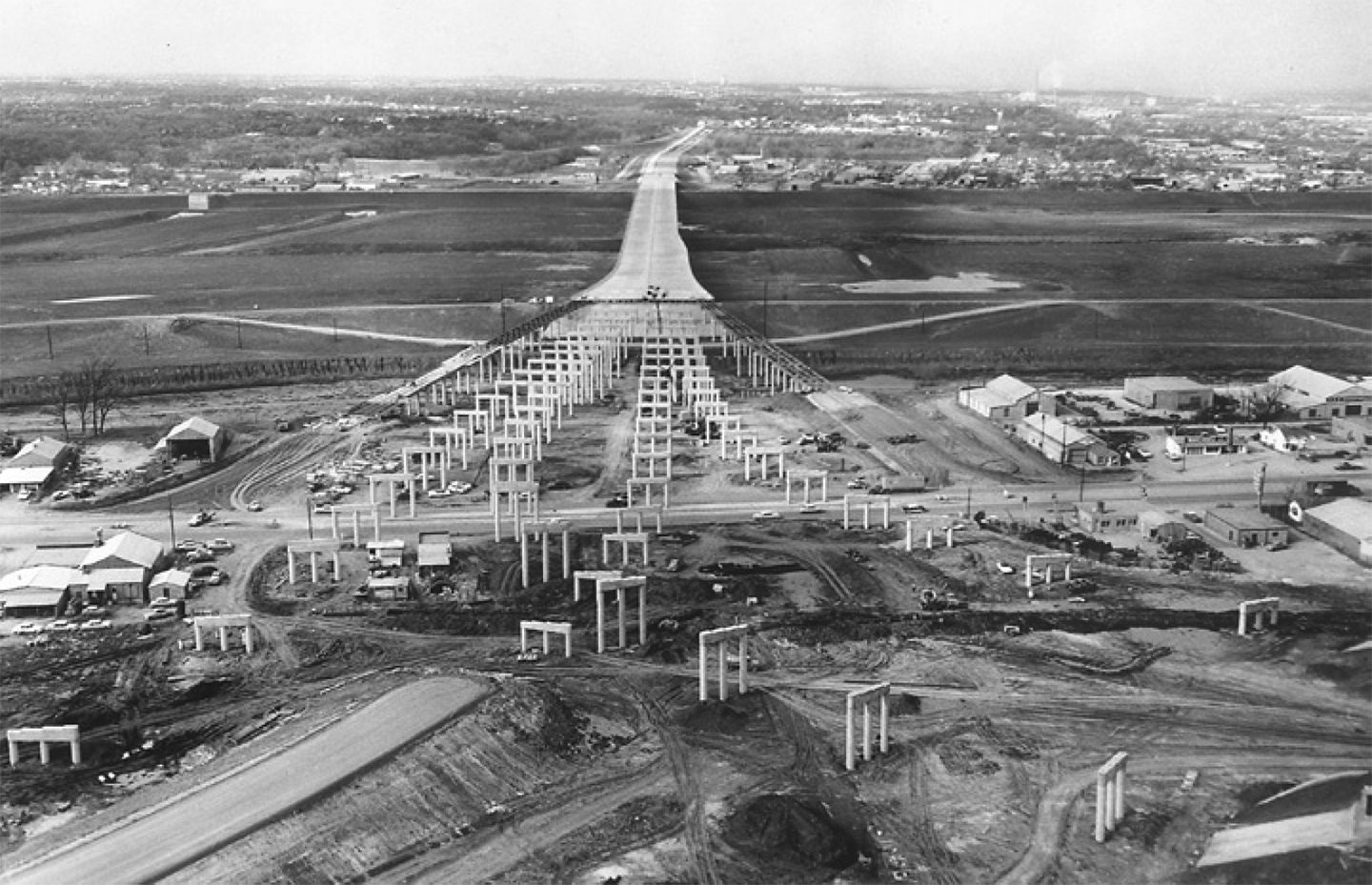
New legislation to make toll financing legal was needed first, however, and getting the legislation passed became the top priority for 1953. After substantial legislative maneuvering, in June 1953 Governor Allan Shivers signed legislation creating the Texas Turnpike Authority (TTA) and made the authority’s first task the construction of the Dallas to Fort Worth expressway. A study of the financial feasibility of the turnpike was underway in December 1953 and in May 1954 the project was determined to be feasible. In December 1954 the TTA gave final approval to issue $58.5 million in bonds to proceed with the project.
The only opposition to the project arose in east Fort Worth where civic groups opposed building the turnpike on the alignment originally designated for a freeway. After substantial controversy in 1954 a compromise was reached in January 1955 in which officials promised to build a new freeway to serve east Fort Worth.
In June 1955 the bonds were sold with a record-low interest rate for toll road bonds, 2.93%, reflecting strong investor confidence in the turnpike and breaking the previous record of 3.32% for the Florida Turnpike. With the funding in the bank, work could proceed at top speed. Right-of-way acquisition began in July 1955 and construction was underway in October with a groundbreaking ceremony in Arlington. The final cost to complete the project was $55.8 million ($462 million in 2013 dollars), $2.7 million below the estimate. On August 27, 1957, the Dallas-Fort Worth Turnpike opened to traffic and a formal dedication ceremony was held on September 5. It was an impressive achievement in project delivery, going from authorization to completion in four years, and preliminary design to opening in just 30 months. Of course, it was a different time with no environment impact statements, federal bureaucracy or formal public involvement. The only thing that mattered was getting the job done.
For a toll of 50 cents, a vehicle could drive the 30 miles between downtown Dallas and downtown Fort Worth in about 30 minutes. Tolls would be collected only as long as needed to pay off the $58.5 million in bonds, and then the highway would be turned over to TxDOT to become a toll-free facility.
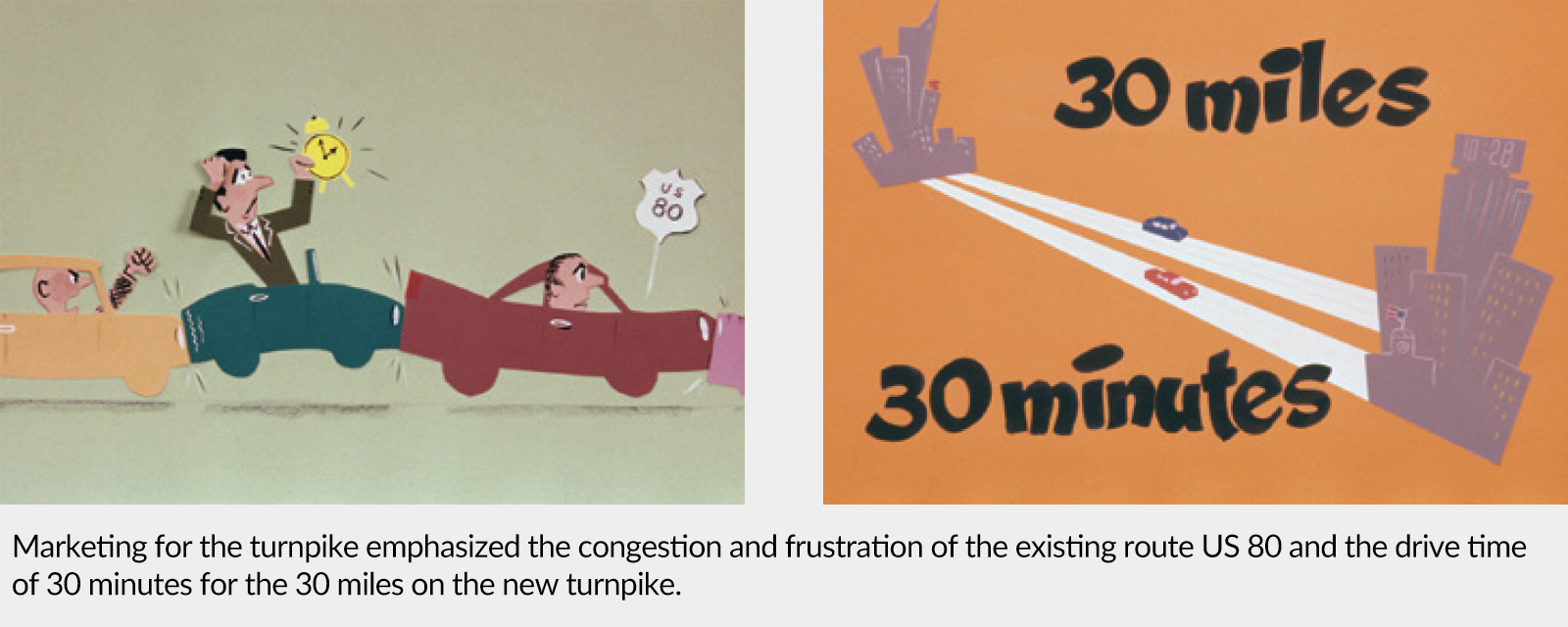
The turnpike opening was also a milestone in the relations between Dallas and Fort Worth, which historically had been characterized by feuding and rivalry. With the turnpike the two cities were united with an efficient expressway, providing new opportunities for cooperation and economic development. The opening of the turnpike coincided with a Businessweek magazine cover story on Dallas and Fort Worth in March 1957, with the special report proclaiming that “evidences of an abatement of the storm of bitterness have been piling up, and today the change is unmistakable.”
East Fort Worth Gets its Freeway
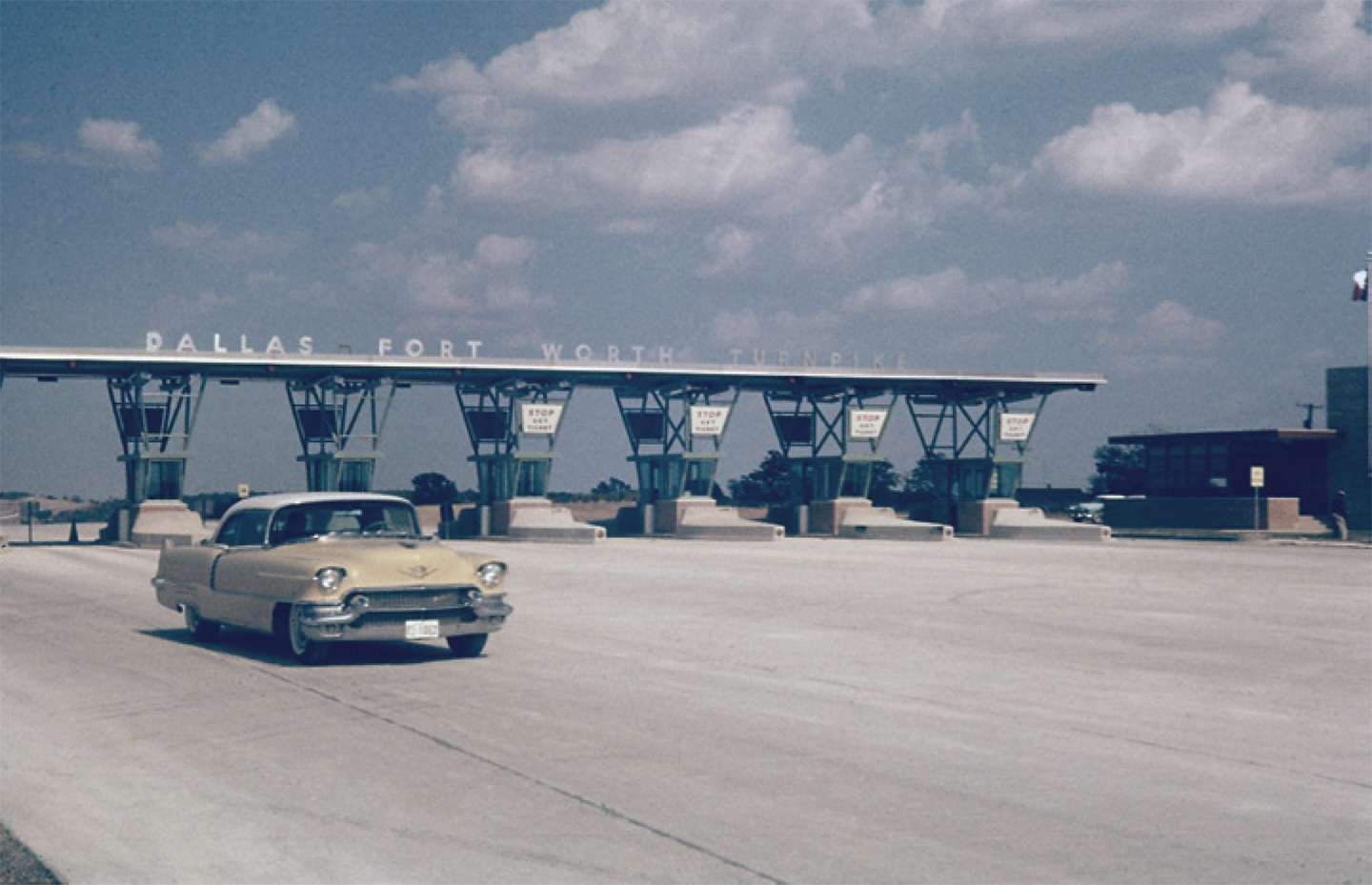
While local officials were pleased with their accomplishment, not everyone was happy. Even though the residents of east Fort Worth had obtained a promise of a new freeway for their area during negotiations to end their opposition to the turnpike in 1955, the turnpike became especially painful when the federal government’s Federal-Aid Highway Act of 1956 became law, unleashing the highway construction boom which would build the Interstate Highway System. So while everyone else would be getting freeways, east Fort Worth was stuck with tolls. It soon became apparent that TxDOT’s promise for an east Fort Worth freeway would be fulfilled with two new freeways, the US 287 freeway which served southeast Fort Worth and the SH 121 freeway which served northeast Fort Worth. Neither freeway provided toll relief for residents of east Fort Worth.
As early as December 1957 there were proposals to make the westernmost section of the turnpike in Fort Worth a freeway. The turnpike and its toll remained a political issue in the following years and in 1964 an agreement was reached to make 3.5 miles of the turnpike, from Oakland Boulevard to downtown Fort Worth, toll-free. The city, county and state joined forces to pay the TTA $2.8 million ($21 million in 2013 dollars) in exchange for free use of the turnpike in Fort Worth. On December 30, 1964, the first vehicles used the turnpike toll free. The distaste for tolls in Fort Worth would later lead to another clash in the 1970s when the turnpike bonds were paid off.
To Toll or Not to Toll
The original agreement to build the turnpike provided for the transfer of the turnpike to TxDOT for free use when the construction bonds were paid off. Even with the 3.5-mile free section at the west end, toll-averse Fort Worth eagerly awaited the day that the tolls would be lifted. Due to steady traffic growth throughout the 1960s, in 1971 it was announced that construction bonds would be retired in 1977, allowing the tolls to be lifted. Soon after the announcement of bond retirement the TTA was promoting the idea of maintaining tolls and using the revenue to finance the Trinity Turnpike, a proposed new turnpike running alongside the Trinity River generally paralleling the existing turnpike. The idea was opposed by the Texas Transportation Commission and Governor Preston Smith, but had some support from business groups looking to get the Trinity Turnpike built. In March 1974 the Texas Transportation Commission killed the Trinity Turnpike and any potential extension of tolls on the Dallas-Fort Worth Turnpike to finance it.
In 1974 TxDOT suggested that the tolls be retained to finance widening of the turnpike, and in 1975 the Texas Turnpike Authority proposed lowering and continuing the tolls. But by May 1975 the Texas Turnpike Authority had given up on extending the tolls and voted to remove the tolls when the bonds were retired, expected in 1977 or 1978. But then other groups were looking to extend the tolls. In 1976 the politically well-connected Dallas Chamber of Commerce stated its position in support of retaining tolls to finance $65 million in improvements and persuaded the TTA to authorize a $300,000 study of the toll extension.
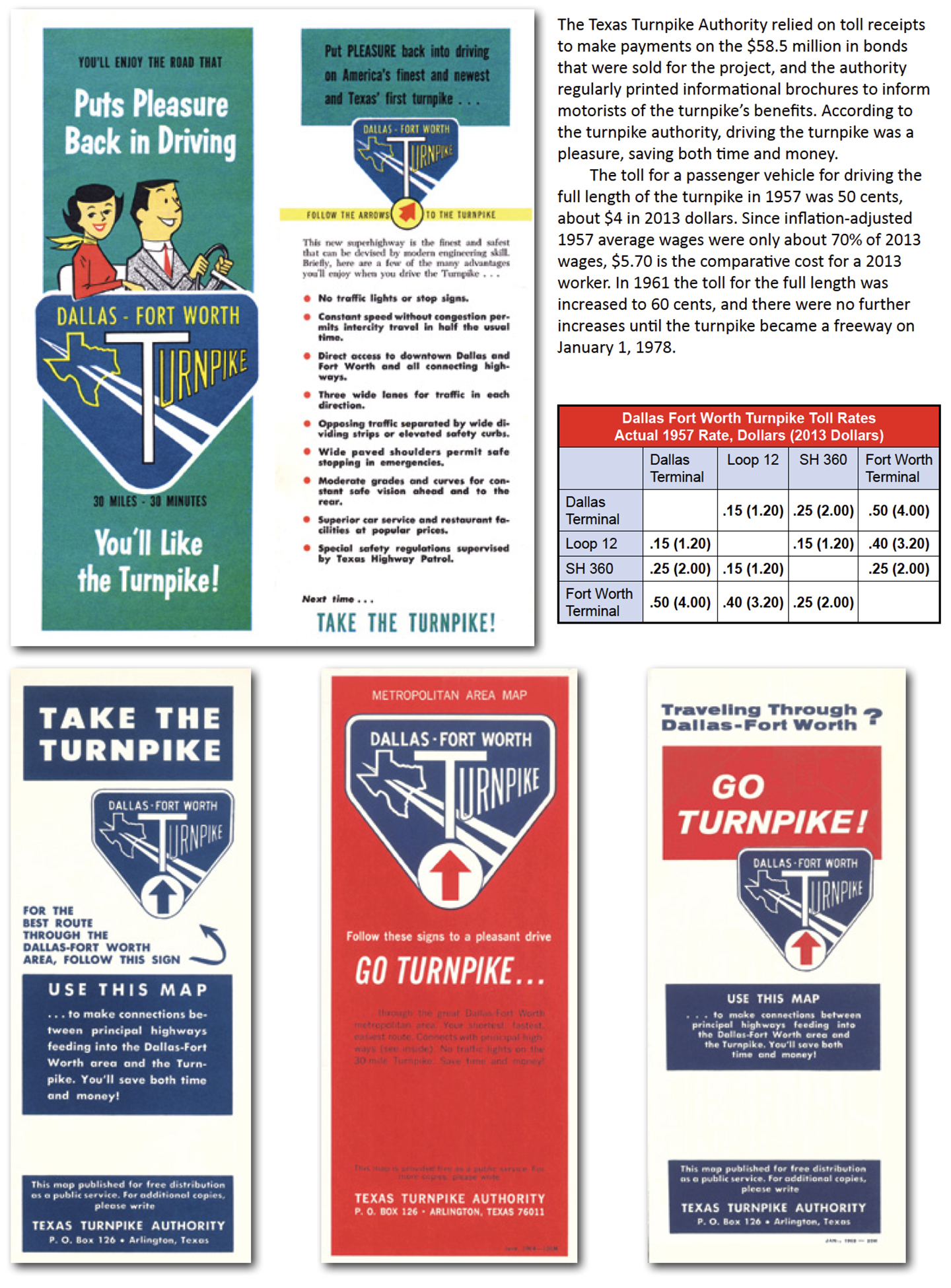
Although Dallas and Fort Worth had, for the most part, moved beyond the conflict which characterized their past relations, Fort Worth was not about to stand by and let Dallas interests keep the tolls in place after the bond retirement. It was time to bring in the lawyers. In August 1976 Fort Worth filed a lawsuit asking the court to permanently bar the TTA from studying the feasibility of continuing tolls to finance an expansion of the turnpike. In December the motion was granted, stopping the TTA’s planned study and ordering the TTA to remove tolls when the last bond payment was made. The TTA appealed the ruling, but by March 1977 political opposition to continuing the tolls was too great and the TTA voted to remove the tolls. Any remaining uncertainty was removed in May 1977 when Governor Briscoe signed a law which called for the removal of tolls by the end of the year.
At 12:00 am on January 1, 1978, the turnpike was turned over to TxDOT and toll collection ended. On January 4 workers began removing the toll booths. The removal of tolls was an event that would occur only once in Texas history and, in the prevailing political climate of 2013, seems destined to never occur again, even as toll roads proliferate in North Texas, Houston and Austin.
Even though the toll booths were removed, the former Dallas-Fort Worth Turnpike remained in a time warp for decades, reminding drivers that it was once a toll road. The most obvious and annoying artifacts were the circuitous interchanges at freeway access points, particularly at the three freeways which intersected the turnpike. Slowly over the following three decades most turnpike artifacts were replaced with modern designs, but in 2013 the interchange at Loop 12 still retained its absolutely crazy connection patterns and the intersection with SH 360 still lacked an interchange, forcing drivers to exit and navigate streets to make the freeway-to-freeway connection. Someday the last traces of the turnpike will finally be erased, but it could very well be a lifetime after the first motorist drove on the turnpike on August 27, 1957.
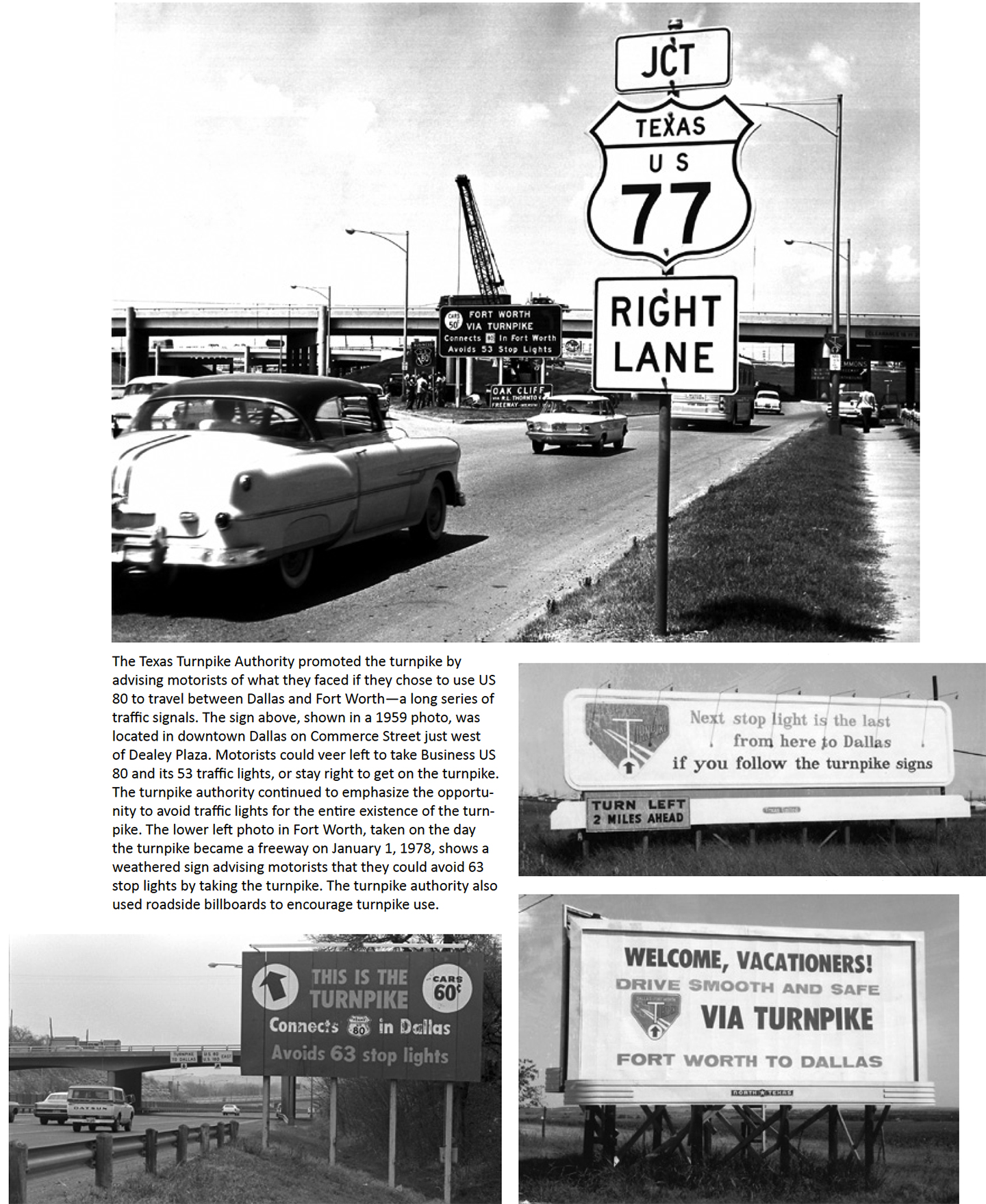
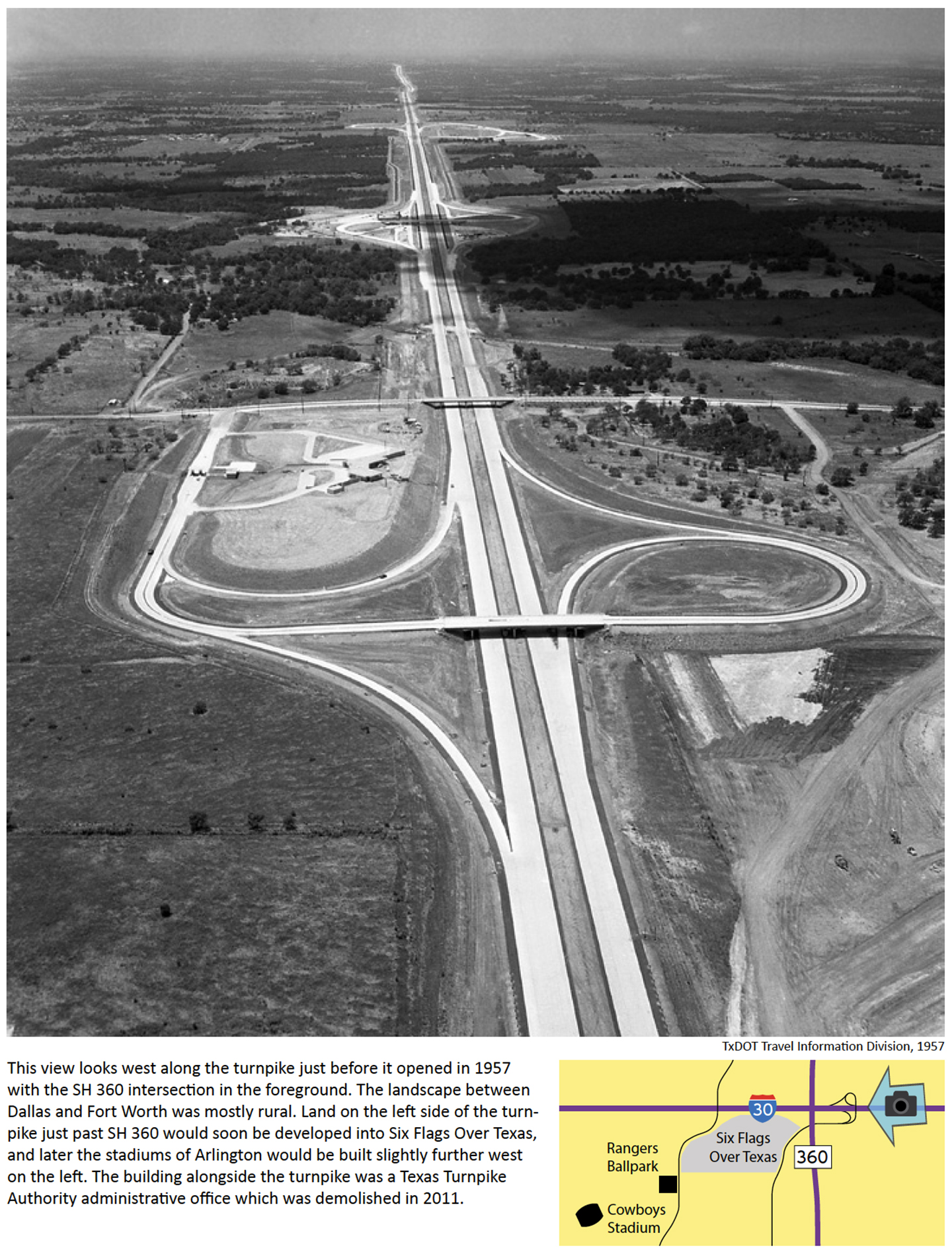
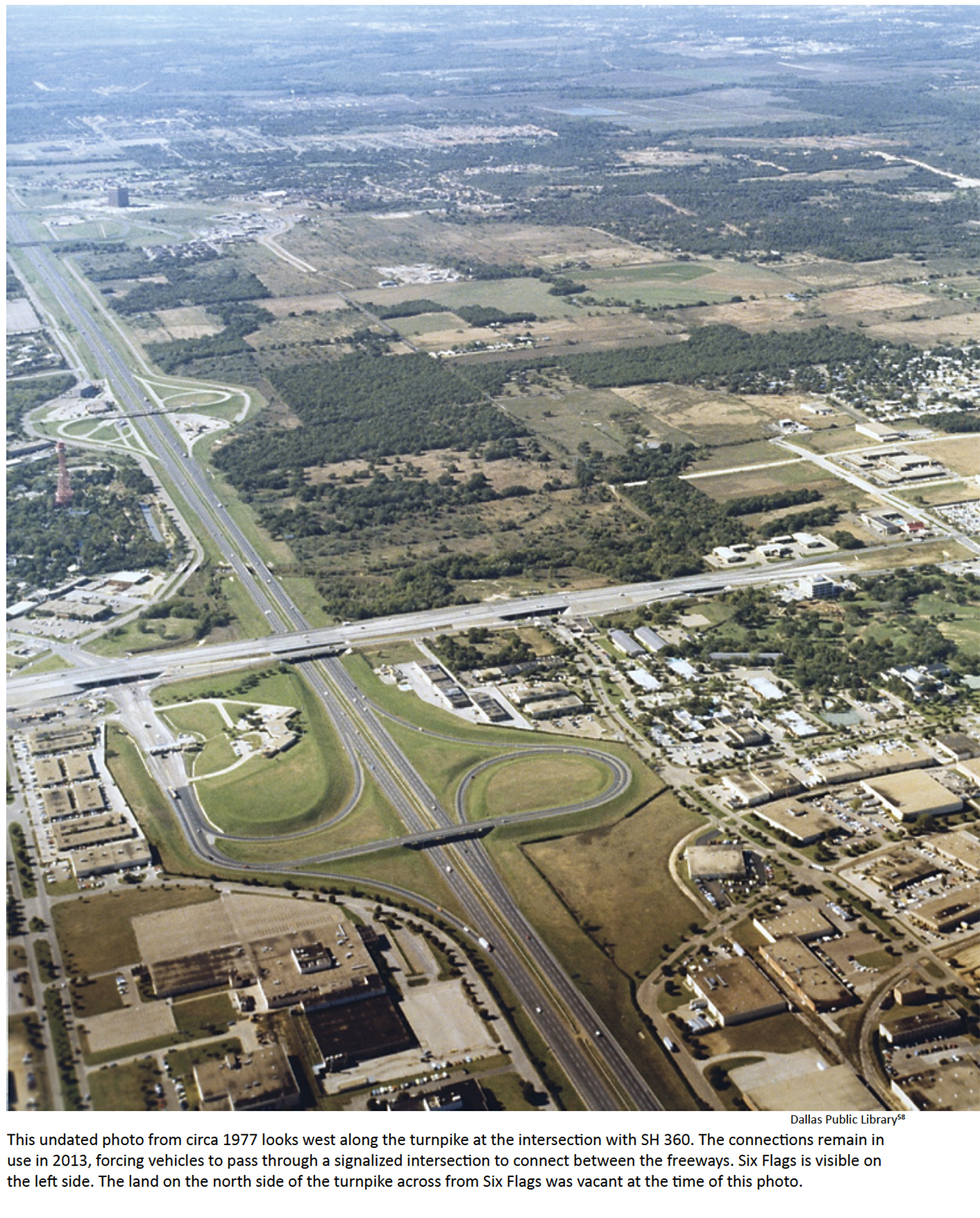
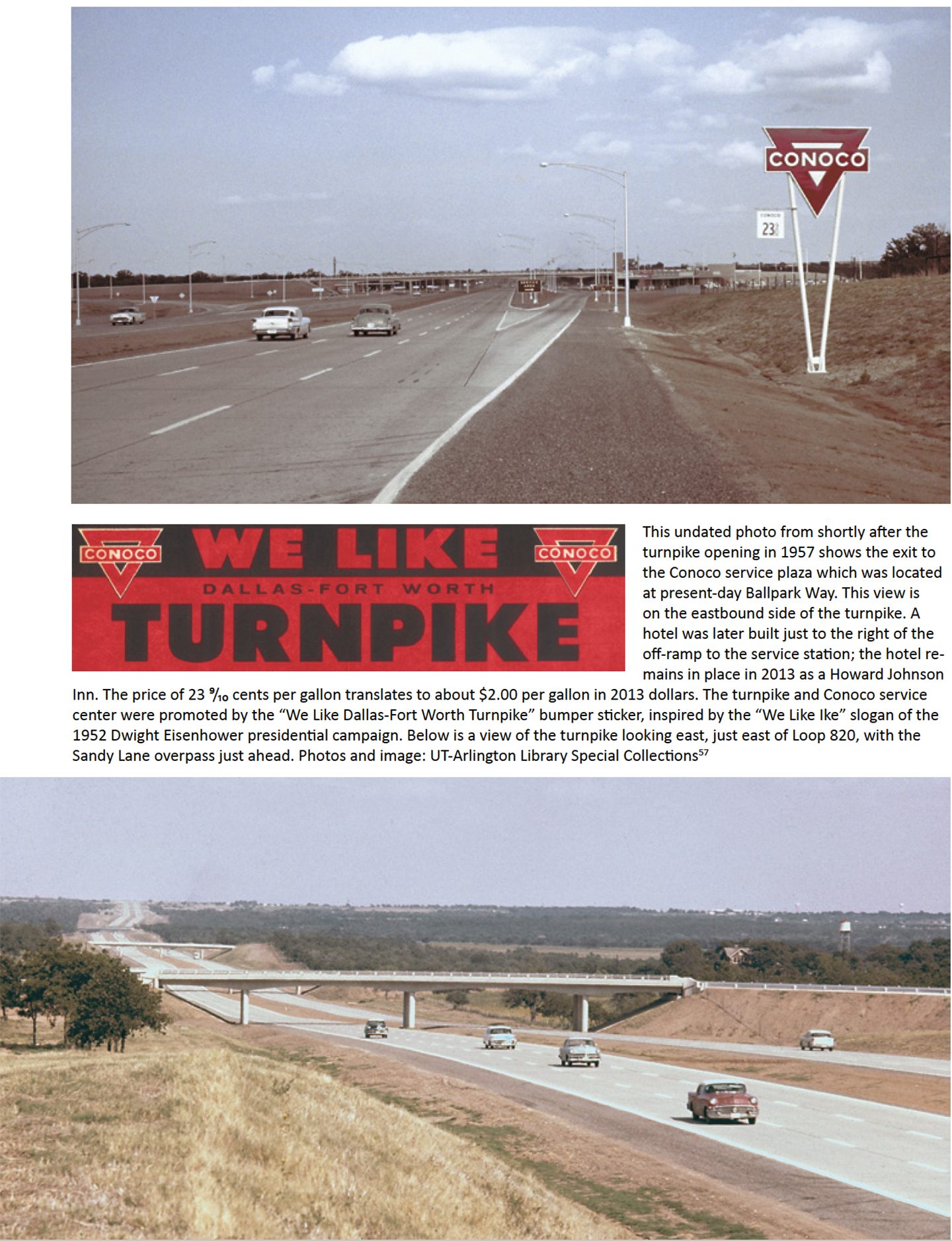
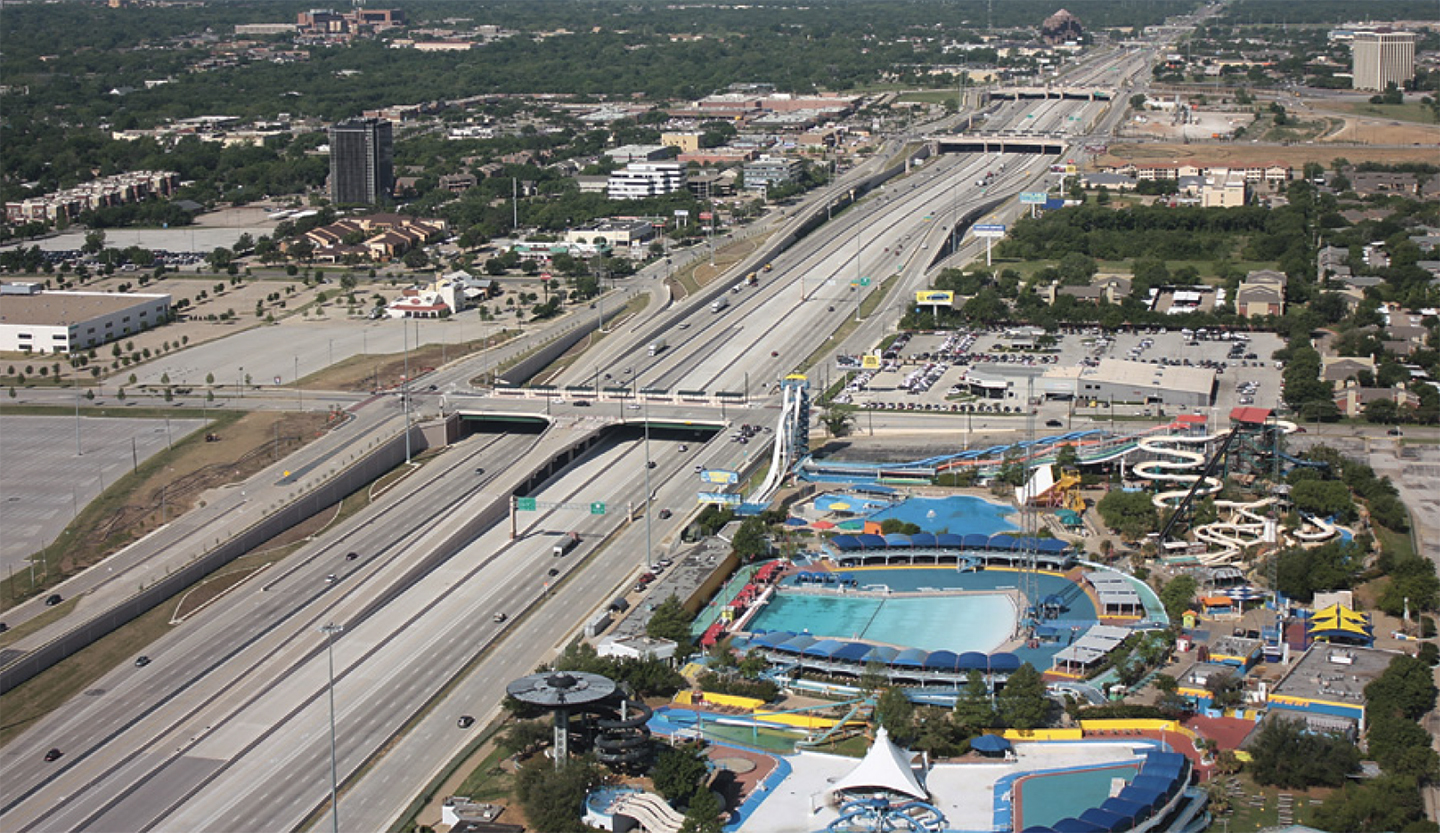
Six Flags Over Texas
Tom Landry Highway originally opened as the Dallas-Fort Worth Turnpike in 1957, passing through a mostly rural landscape between Dallas and Fort Worth. But soon the turnpike would have its own destination near its midpoint. In the mid-1950s political officials in Arlington and Grand Prairie were looking to develop the area around the turnpike. Arlington Mayor Tom Vandergriff went to New York to make an investment proposal to the Rockefellers but came back empty handed. Then Dallas real estate developer Angus Wynne Jr became involved. He went to New York to make another proposal to the Rockefellers and this time came back with the money, announcing financial backing in July 1956 for the Great Southwest Corporation which would focus on industrial property. But Wynne had another idea for some of the prime land in his portfolio.
Inspired by the success of Disneyland in Anaheim (Calif.), which was specifically located along Interstate 5 to achieve maximum accessibility, Wynne conceived the idea of a theme park unique to Texas. Sections of the park were themed with the six flags which have flown over Texas—Spain, France, Mexico, the Republic of Texas, the Confederacy and the United States. Planning was underway in early 1958 for Six Flags Over Texas and the amusement park officially opened on August 5, 1961. The early park was rather quaint and simple compared to today’s emphasis on thrill rides. Original attractions included a horse-driven stagecoach, a boat ride around Skull Island, simulated wild west gun battles in the street and a petting zoo.
Six Flags received national attention, becoming a big success and by 1965 was easily the number one tourist attraction in Texas. Six Flags would eventually expand to be immediately adjacent to Tom Landry Highway, with the double-loop Shock Wave roller coaster opening alongside the highway in 1978 and launching the era of thrill rides. The huge roller coasters and the Superman Tower of Power rapid vertical lift constructed in the 1990s and 2000s provided an impressive view for motorists on today’s Tom Landry Highway.
Seven Seas Marine Life Park
Seven Seas Marine Life Park was a marine mammal park and animal theme park built and owned by the city of Arlington. The park opened on March 18, 1972. The 35-acre site was located off IH-30 near Six Flags Over Texas and adjacent to Arlington Stadium.
The park lost almost half a million dollars in 1972, 1973, and 1974 and after the 1975 season, the animals were sold. The park reopened for the 1976 season as Hawaii Kai. The attendance for that season was at an all-time low and the city council of Arlington voted to close the park because it did not generate enough revenue to both pay its operating expenses and pay off the bonded indebtedness.
The property is now the site of the Arlington Sheraton Hotel and has several buildings on the property that date back to the park. In addition, there is a remaining piece from the Japan garden, a very nice, large bridged Pagoda still exists outside the hotel's pool court area. Sheraton Arlington is slated to be demolished by September 30, 2026 to make way for a new Loews Hotel project.
Lion Country Safari/International Wildlife Park, 1972 - 1991
Lion Country Safari opened on May 27, 1972, just northwest of the intersection of the Dallas-Fort Worth Turnpike and Belt Line Road east of Arlington in Grand Prairie. The 485-acre park allowed visitors to drive through areas with free-roaming African wildlife, including lions, cheetahs, white rhinos, hippos, giraffes, zebras, elephants, chimpanzees, ostriches and a wide variety of antelopes. After years of financial difficulty in the mid-1970s, the lions were confined in 1977 to allow motorists to open their windows and the attraction was later renamed International Wildlife Park. It operated successfully until 1989 and 1990, when Trinity River floods inundated the property which is located in the river flood plain. Repairs were made after the 1989 flood, but after the 1990 flood the park operated in a reduced capacity and was permanently closed in December 1991.
The Stadiums of Arlington
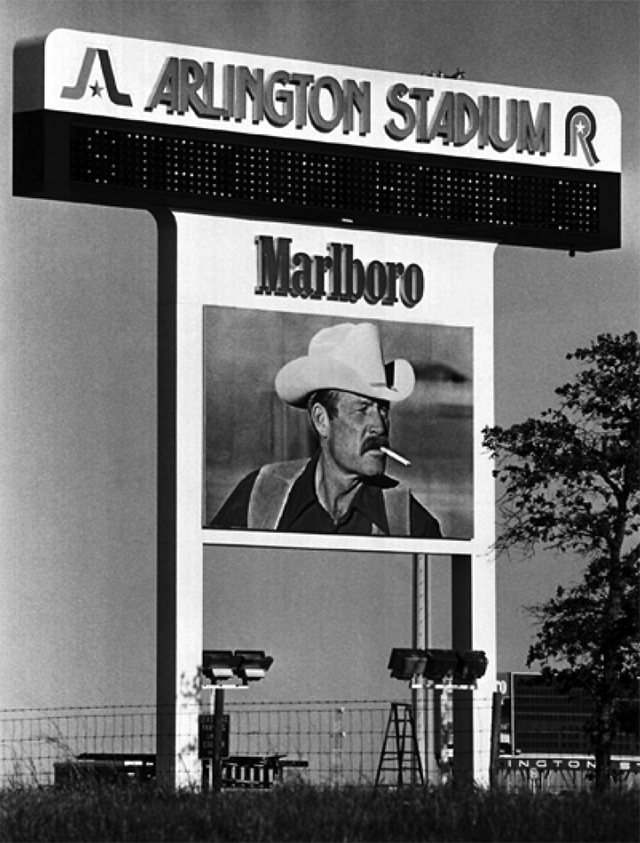
The stadium era in Arlington began on April 23, 1965, when the minor league Dallas-Fort Worth Spurs baseball team played the first game at the brand-new Turnpike Stadium. The 10,600-seat stadium was simple and basic, but was designed to be the core of a much larger stadium suitable for a Major League team.
By 1970 there were a few financially ailing Major League teams and local officials sensed an opportunity to bring one to North Texas. In April 1970 Arlington voters approved expansion of Turnpike Stadium to meet Major League standards. The Washington Senators emerged as the leading candidate for relocation in the summer of 1971 and in September 1971 it became official—the Senators would relocate to Arlington for the 1972 season and become the Texas Rangers. In November 1971 Arlington City Council renamed the site Arlington Stadium. The first Rangers game at Arlington Stadium was April 21, 1972.
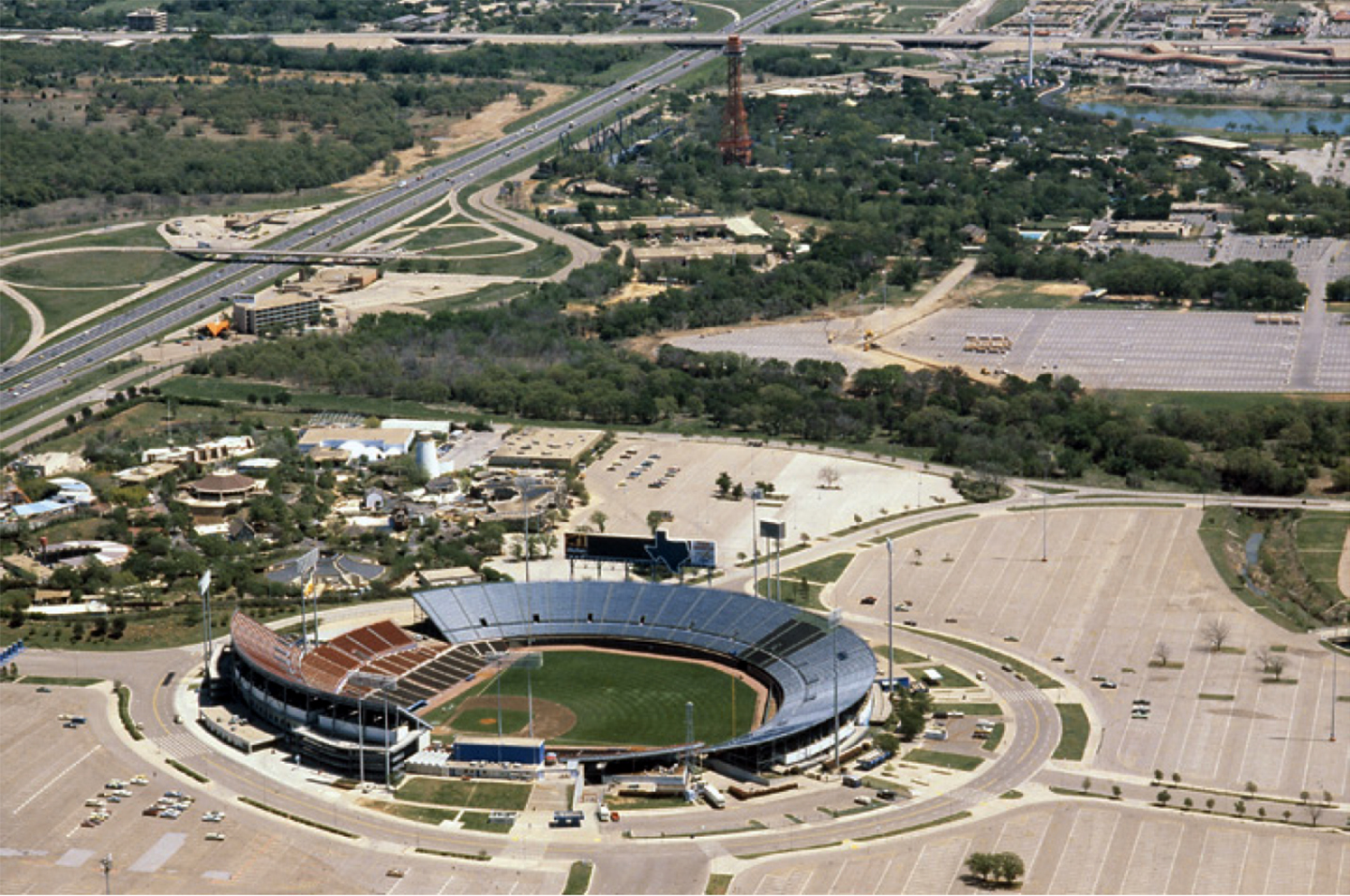
The modern era for stadiums began in April 1989 when a group of investors led by George W. Bush purchased a controlling interest in the Rangers. The new ownership immediately began efforts for a new stadium and in October 1990 an agreement was reached with the City of Arlington for a January 1991 vote on a half-cent sales tax increase to back $135 million in city-issued bonds for the planned $165 million ballpark. Voters approved the stadium with 66% of the vote on January 19. The first game in Rangers Ballpark, with a final price tag of $189 million, took place April 11, 1994.
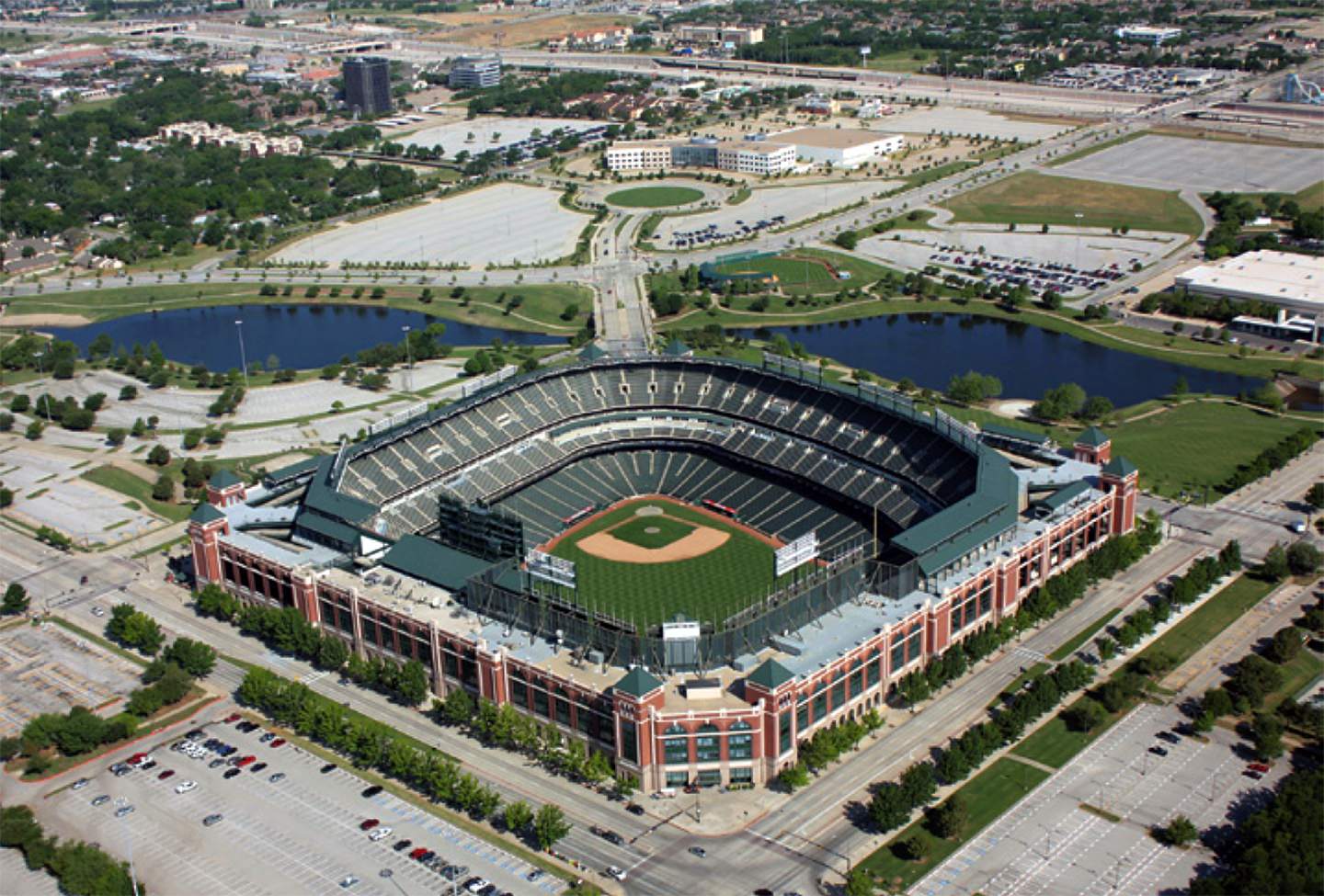
The crown jewels of Arlington stadiums were yet to come.
In the early 2000s Cowboys owner Jerry Jones was looking for a site for a new stadium with Dallas and Irving the leading contenders. When finance negotiations with Dallas County broke down in June 2004, Jones reached an agreement with the City of Arlington for a $325 million package financed by several tax increases including a half-cent sales tax increase. When voters approved the stadium finance package in November 2004 with 55% of the vote, Arlington’s next stadium was ready to move forward.
The new Cowboys stadium was initially projected to cost $650 million. But that budget wasn’t enough to fulfill Jerry Jones’ plan to build the best stadium in the NFL, and ultimately one of the most impressive in the United States and even the world. When the stadium had its first public event on June 6, 2009, the final cost came in at a stunning $1.2 billion. AT&T Stadium, originally named Cowboys Stadium until July 2013, is the crowning achievement in the Arlington stadium story, and a fitting monument to be in the corridor of the freeway named for North Texas sports legend Tom Landry.
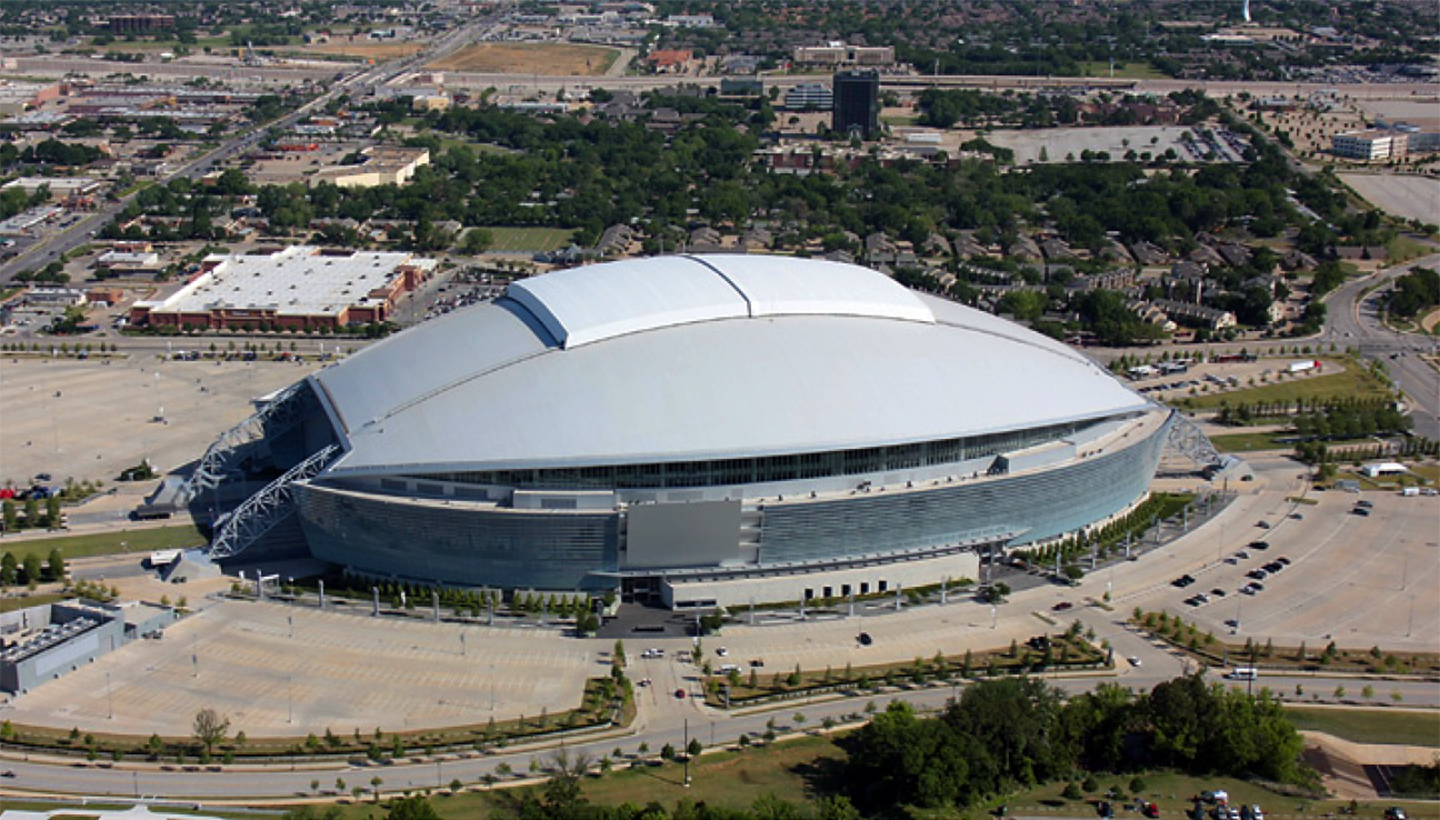
On May 20, 2016, the Rangers announced that they would vacate Globe Life Park, formerly known as Rangers Ballpark and later, the Ballpark in Arlington. Their new stadium was to be constructed in a public/private partnership and have a retractable roof. The new ballpark was approved on the following Election Day. HKS, Inc. was announced as the architect on January 5, 2017.
A new shopping mall, a Loews Hotel, and a ballpark village were planned to go along with the new stadium. After the Rangers left Globe Life Park, it was then to be renovated for football and soccer use and renamed Choctaw Stadium.
On December 14, 2019, a section of the roof caught fire while under construction.
Globe Life Field was originally scheduled to open on March 23, 2020, but because of the COVID-19 pandemic in Texas, the start of the 2020 Major League Baseball season was delayed for several months. Globe Life Field opened for a high-school graduation on May 29, 2020.
On July 24, 2020, the Rangers hosted their first regular-season game against the Colorado Rockies, which they won 1-0. The Rangers played two exhibition games against the Rockies on July 21 and 22 at Globe Life Field. Joey Gallo hit the first home run at the stadium on July 26.
On November 1, 2023, the Rangers won the World Series at Globe Life Field after having defeated the Arizona Diamondbacks in five games, thus achieving their first World Series championship in franchise history.
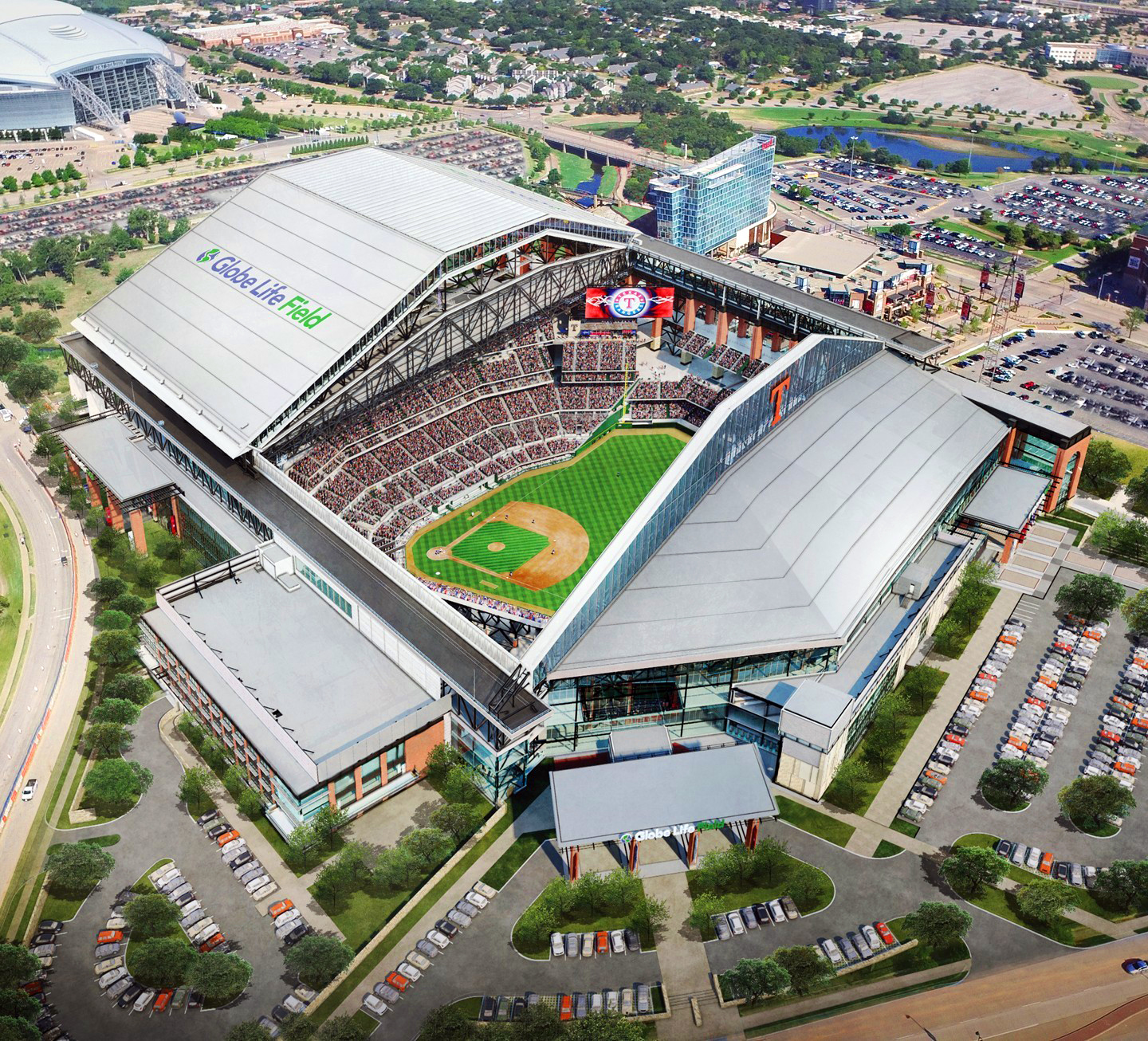
...to be continued.
